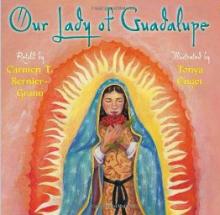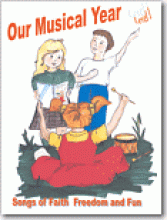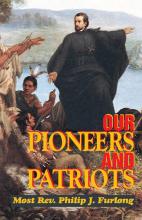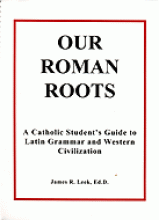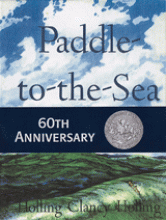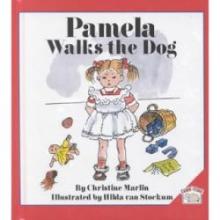No name
Our Lady of Guadalupe
I never cease to marvel at the wonder-full story of Guadalupe. This new picture book does a fabulous job of retelling it, with historical accuracy, gentleness, and vibrant illustrations. This lovely book will make a very nice gift to a child, and the child's older siblings and parents will enjoy it as well.
Although the story of Guadalupe is one of the most well-known Catholic stories, the effects of this historical event are intricately woven in Mexican-American history. I believe this book will be of interest to any reader, independent of denomination, because of its historical ramifications. In the millions who visit the largest Marian shrine in the world in Mexico, there are many who are there for historical and cultural interest. A high quality, beautiful picture book! Highly recommended.
The "See Inside" feature on Amazon for this book is very generous and one can see much of the book including the excellent Author's Note at the end.
Our Lady of Guadalupe Cut'n'Color Kit
Our Lady of Guadalupe Cut ‘n Color is actually a 3-dimensional story book about Our Lady of Guadalupe. Once completed, this cut, color, and assemble kit creates a lovely storybook attached to an attractive diorama that children can use with the paper dolls to act out the story. A few parts will need some adult supervision. On the bottom of the “book” are pages of the story that you turn while the diorama remains in view. Each kit includes the book, scenery, church, and paper dolls of Juan Diego, the Bishop, and Our Lady of Guadalupe all on card stock with easy to follow instructions. A craft knife or X-acto knife is required. The picture on the cover does not give justice to how beautiful this project is. Once completed, your child will have an attractive diorama to play with and a story to read over and over again.
Our Musical Year
Level 1 (1st and 2nd grade) includes 93 songs 130 pg. spiral-bound manual and two CDs - one learning CD and one sing-along (instrumental)
Level 2 (3rd-6th grade) includes 91 songs 142 pg. spiral-bound manual and 3 CDs. Includes music instruction and basic theory lessons
We've had a lot of frustration with finding a good music program for our family. We were unable to use the songbook that came with our package curriculum because I did not know most of the songs and we don't have a piano or the ability to properly play them if we did. When I tried to find recordings of the songs from the songbook, I was told it was out of print. I looked for other songbooks with tapes or CDs to go along with it but I was not happy with the ones I bought. They either did not have the traditional Catholic songs for children or when I was able to find some of the music for the songs I wanted my children to learn, there was no words for it to help them follow along. Also, it was very difficult to teach them when there was other children singing on the tape. I had a hard time getting them to put forth any effort and participation in music class and felt they were not learning much about music.
Finally, we purchased Our Musical Year at a homeschool conference. Since we have started using the book and music in this program, our children have increased their participation so much because they enjoy it and I feel they are really learning. Now they want to use it not only for music class, but also for fun. They are already singing some of the songs around the house and we have only used it a few times. I feel it is well worth the money because I can use it for more than one year and for more than one student. Also I think of all the money I wasted on other things to try to help me teach music class. I really like how the book is set up to go along with the liturgical year and the fun and patriotic songs are great too. I feel these are the kind of songs I want my children singing instead of what they hear on the radio. They are not just learning songs to sing either. They are learning about how music works with the notes going up and down. The learning CD is slow enough and clear so they can really hear the notes and they can understand the musical terms I teach them. This is my first year home schooling my 7 year old and 4 year old. We also have a 1 1/2 year old and a baby due this summer. This is just what I have been looking for all year long. Now I will feel better prepared for next year.
Our Pioneers and Patriots
Our Pioneers and Patriots begins with a review of Viking exploration and continues through the history of the United States to the time of President Roosevelt and the New Deal. The text is direct and factual, focusing on key people and events. Read straight through, this book would bore most children; however, when read a page or two at a time the presentation style is interesting and easily understood. Fr. Furlong has a unique way of digesting complex information into a few short sentences. These sentences are written in a conversational tone that would appeal to most young students. For example...
"The Boston Tea Party made the British very angry. The owners lost their tea and the government lost its tax. Worst of all the affair was an act of defiance. An act of defiance is a refusal to obey an order or command. King George III would not overlook that. The people of Boston must be taught to obey. The port of Boston was therefore declared closed." p. 201
Each of the twelve units is broken into unnumbered chapters and subsections making for many natural stopping points if reading time must be limited to just five or ten minutes a day. Each chapter is preceded with a brief "Read to Learn" section that sets the tone for the upcoming material and alerts the reader to key points to be remembered. Following each chapter is a Study Summary that includes a listing of key people, events and dates. An activity section provides mapping activities and other projects. These projects are meaningful and would bring depth to the student's study of the chapter material. The study test provides an easy means for evaluation.
This book provides the important factual information needed for Junior High students, but it does not provide enough material for critical thinking or integration needed by that age group. As a Junior High textbook it should be supplemented with research assignments, biographies and journal articles or historical fiction.
In comparison to From Sea To Shining Sea, also reviewed on this page, Our Pioneers and Patriots is more succinct, but it does not tell the story of United States history as well as From Sea to Shining Sea. While the latter paints the larger picture of our history in a way that is captivating to students, Our Pioneers and Patriots is better used to bring to life isolated events and people. This text is suitable for Grades 4-6, and may be used in conjunction with other resources for Grades 7-8.
Our Roman Roots
Ecclesiastical Pronunciation, 15 weeks of lessons
Our Roman Roots was designed to teach children Latin through the functional method. This means that the material to be learned is presented in relation to what is already known to the child. Vocabulary and grammar are taught as aids to reading. This is unlike the approach used by many programs which emphasize grammar through chant and vocabulary through memorization. For example in the first lesson the child is given a short quote in Latin (eg. "To the stars through difficulties.") followed by an English translation of the quote. The student is instructed to draw lines between those Latin and English words which he thinks are the same. Later he is given vocabulary (many with illustrations) which contain some of the words that were in the original quotes. These quotes are used later to encourage critical thinking. Through repeated exposure to phrases, and some comments from the author, grammar is gradually introduced. Each weekly unit also involves the memorization of a Latin song or chant such as "The Lamb of God" and "The Our Father". Review is built into this program which comes with an easy to follow cassette tape that uses ecclesiastical Latin. My only complaint about this program is that a few words are introduced and never defined. The author suggests students can do each lesson alone in 45 minutes. In our family the lessons took over an hour and the student often didn't grasp parts of the material. I now sit side by side and do the lesson along with my child with both of us finishing in about 30 minutes. Our family adheres to the Classical approach which encourages chants and memorization (the opposite of what is used in this program), however ORR is a most pleasant introduction to Latin. Our family uses "English From the Roots Up" in second and third grade, "Our Roman Roots" in fourth grade and "Latina Christiana" in fifth grade. The student and teacher need no previous knowledge of Latin to use this program. While there are only 15 weeks of lessons most families will not be able to tie up this much time every day doing Latin. We do Latin every other week in our house, with quick review during the off week.
Our Sunday Visitor's 2008 Catholic Almanac
Part One: News and Events: The Year in Review and News in Depth(includes segments on Pope Benedict XVI, Papal Documents and Announcements, Special Reports on International News, Special Reports on National News, Life Issues and Meetings of U.S. Bishops) Part Two: The Teachings of the Catholic Church Doctrine of the Catholic Church, Glossary, The Church Calendar, Liturgical Life of the Church, The Sacraments of the Church and The Communion of Saints. Part Three: The Church Universal Dates and Events in Catholic History, The Papacy and the Holy See, The Roman Curia, Hierarchy of the Catholic Church, The Universal Church, Eastern Catholic Churches, The Catholic Church in the U.S., United States Hierarchy, Biographies of American Bishops, United States Conference of Catholic Bishops, Minority Catholics in the U.S., Statistics of the Church in the U.S., The Catholic Church in Canada, The Catholic Church in Mexico. Part Four: The Life of the Church in the World Consecrated Life, Apostolates and Ministries, Catholic Social Services, Education, Catholic Communications, Ecumenism and Interreligous Dialogue, Separated Eastern Churches, Reformation Churches, Interreligious Dialogue.Although this is a complete list of main categories and general topics, it doesn't give a sense of the detail and usefulness of the overall content. I'll try to give a few examples that might be particular useful to Catholic homeschool families, to give a sense of the content: In the section on "The Papacy and the Holy See" from Part Three, you'll find (among other things) a complete lists of popes as well as a more detailed overview of the Popes of the 20th Century. Here's a one of the segments (entitled "Peace Efforts") of the mini-biography of Pope Pius XII, who was Pope during World War II. I think this gives a good sense of the important facts which have been carefully chose and supported in the text:
Before the start of World War II, he tried unsuccessfully to get the contending nations - Germany and Poland, France and Italy- to settle their differences peaceably. During the war, he offered his services to mediate the widened conflict, spoke out against the horrors of war and the suffering it caused, mobilized relief work for its victims, proposed a five-point program for peace in Christmas messages from 1939 to 1942, and secured a generally open status for the city of Rome. He has been criticized in some quarters for not doing enough to oppose the Holocaust. This is a matter of historical debate, but it is a fact that through his direct intercession many thousands of Jews in Rome and Italy were saved from certain death, and he resisted wherever possible the threat of Nazism to human rights. Such were his contributions to assisting Jews that the rabbi of Rome, Dr. Abraham Zolli, was converted to Catholicism, and upon his death, Pius was praised by Golda Meir for his efforts. After the war, he endorsed the principles and intent of the U.N. and continued efforts for peace.Also, in the same overall section is a 36 page country-by-country overview of Catholic statistics (number of religious, Catholic population, percent of the total population that is Catholic and things like that) and a paragraph briefly explaining the history of the faith in each country. It's a wonderful supplement to geographical studies and a place to find interesting information on current missionary efforts of the Church. I could readily imagine homeschool families choosing countries with small minorities of Catholics (such as Turkmenistan, which has only two priests to serve a population of approximately 1000 Catholics). Here is a list of some of the other resources contained in this Almanac that may be of interest (there are many, many more besides these):
- Books of the Bible (including information on books that are rejected by Protestant denominations and overviews of each book)
- A mini Old Testament Bible timeline
- A list of Apostolic Fathers, Fathers of the Church and Doctors of the Church with a brief biography of each
- A 32 page Catholic Glossary
- A detailed liturgical calendar
- An overview of major Holy Days and other Observances
- Extensive listing of saints, including a list of traditional Patrons and Intercessors and recent Canonizations
- A ten page timeline of Catholic History
- A listing of all Papal Encyclicals from 1740 to the present day (The most recent encyclical included here is Deus Caritas Est)
- A Chronology of U.S. Catholic History
- A list of missionaries (with very brief biographies) to the Americas
- Lists of Cathedrals, Basilicas and Shrines in the United States
- An extensive listing of Catholic Colleges and Universities, including website and phone number, and current enrollment.
Owls in the Family
Paddle-to-the-Sea
Pamela Walks the Dog
My two reading-age children (ages 6 and 8) so enjoyed the punch line that they fought over who would be the first one to read the story to Daddy. As evidenced from the sticky fingerprints on every page, my younger children (ages 2 and 4) have been poring over the book as well. The story could be easily read by a younger reader who knows most of the phonograms (the story includes a few "challenging" words, such as "thought" and "would").

